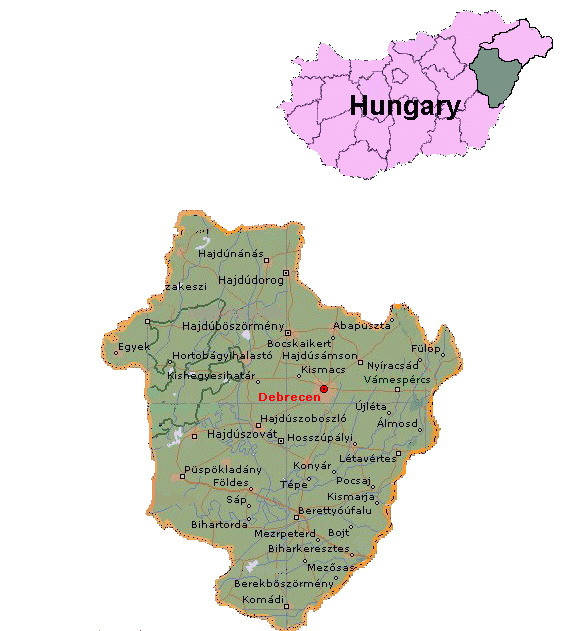|
||||||||||||
| also known as: Debrezin (Ger), (Hebrew) דברצן 47°32' N / 21°38' E |
||||||||||||
| ~ Introduction ~ |
||||||||||||
| ( Click the arrow in the buttons |
||||||||||||
|
||||||||||||
| ~ Maps ~ |
||||||||||||
| Hajdú-Bihar megye, Hungary Map: Copyright ©2010 by Marshall J. KATZ |
||||||||||||
|---|---|---|---|---|---|---|---|---|---|---|---|---|
|
||||||||||||
| NOTE: Clicking a link will open a new page. |
||||||||||||
|
||||||||||||
| ~ History ~ |
||||||||||||
| Jews were not allowed to settle in Debrecen until a decree, published in 1840, permitted their presence. By 1848, the Jewish population numbered 118. They were allowed to purchase real estate in 1863. |
||||||||||||
| The city grew in the 19th century. Thanks to its Jewish community, it became one of the major political, financial and cultural centers of eastern Hungary. Jews were leaders in commerce and industry, as well as comprising some 80% of the professional classes. By 1920, the Jewish population numbered 10,170 (10% of the total), up from 3,089 in 1880. Jews owned nearly half the large property holdings in the area. |
||||||||||||
| In the aftermath of World War I, anti-Semitic attacks occurred in Debrecen, mainly from the students of the new local university. The town's Jewish youths fought back with notable results. |
||||||||||||
| The 1930 census showed a Jewish population of 10,044. |
||||||||||||
| After Hitler's rise to power in 1933, anti-Semitic attacks resumed, often with official sanction. |
||||||||||||
| The Hungarian anti-Jewish laws of 1938 and 1939 affected Jewish businesses and severely limited Jewish participation in economic life. Many of Debrecen's Jews became destitute. The community's reaction was to turn inwardly and, as such, they gravitated toward Zionism or sought comfort in exploring their Jewish heritage more deeply. |
||||||||||||
| In the summer of 1939, Jewish men from Debrecen were drafted into the Munkaszolgalat (Hungarian labor battalions) and sent to the Ukraine, where many died in the minefields. |
||||||||||||
| By 1940, there were about 12,000 Jews living in the town. |
||||||||||||
| In the fall of 1941, Jews of Galician or Polish origin were expelled, many murdered upon reaching Kamenets-Podolski (Ukraine), reducing further the Jewish population to 9,142. In 1942, more Jews were drafted into the Munkaszolgalat and sent to the Ukraine. |
||||||||||||
| German forces entered Debrecen on 20 March 1944 and quickly ordered the disbanding of the existing Jewish leadership and forcing it to reorganize as the Zsido Tanacs (Jewish Council), under the leadership of Rabbi Pal (Meir) WEISZ. A Jewish police force was set up under a former army captain, Bela LUSZTBAUM. On the last day of March, a decree called for Jews to wear the yellow Star of David prominently on their clothing. |
||||||||||||
| Early in April, Jewish-owned automobiles were confiscated and Jewish-owned telephones disconnected. On 8 April (during Passover), a handful of Jewish leaders were taken hostage by the authorities and imprisoned at nearby Hajduszentgyorgy. Eventually, three hundred Jewish notables from the Debrecen area were confined therein. On 21 April, Jewish-owned stores were forcibly closed. The following week witnessed the public burning of books considered "Jewish" or too liberal for the Hungarian right wing; it was directed by the anti-Semitic newspaper editor Mihaly Kalosvari BORSCA. |
||||||||||||
| On 28 April 1944, the order to set up a ghetto was issued by the mayor, Sandor KOLCSEY. Ironically, KOLCSEY and the city secretary, Jozsef ZOLD, voiced their opposition to erecting a ghetto; this led to their ousting by Lajos BESSENYEI, the Debrecen area chief magistrate. Lajos CSOKA became the new mayor. On 9 May, the boundaries of the ghetto, which was to be established on the western side of the city, were established. It had two parts, known as the "large" and the "small" ghetto, which were divided by Hatvan Street. The Jews of the city were forced to build the wall enclosing the ghetto, which stood 8.9 feet (2.7 m) high. On 15 May 1944, the ghetto was declared finished and the process of forcing the Jews into it began. |
||||||||||||
| Local Hungarian police guarded the ghetto, whereas the Jewish police were charged with keeping order within its walls and handing over those Jews whom the authorities wished to interrogate. Each Jew was allocated 43 square feet (4 sq m) of space, which meant that most rooms contained at least one entire family and often more. On 7 June, all traffic in and out of the ghetto was prohibited, including that of Jews leaving the ghetto for work. |
||||||||||||
| Two weeks later, on 21 June 1944, Hungarian gendarmes entered the ghetto and transferred the Jews to the nearby Serly brickyards. There they joined the Jews from the neighboring communities of Balmazujvaros, Hajduboszormeny, Hajdudorog, Hajduhadhaz, Hajdunanas, Hajdusamson, Hajduszoboszlo, Teglas and Vamospercs, totalling 13,084 Jews. At the brickyards, the Jews were stripped of their remaining valuables. A small group was sent to Hajduszentgyorgy, from where they were deported beginning on 26 June 1944. |
||||||||||||
| During the period of ghettoization and deportation, news of the so-called Kasztner train reached Debrecen via messengers from the Zionist youth movement who posed as gentiles. They told the leader of the Orthodox community, Shlomo STRASSER, that anyone from Debrecen could be included in the designated quota for the city. During the deportations, ten families - including those of Rabbi WEISZ, Rabbi STRASSER and Zionist leaders - were taken to the Columbus Street camp in Budapest. Soon thereafter they embarked on the Kasztner train, which eventually brought them to freedom in Switzerland. |
||||||||||||
| The first two trains, with 6,841 relatively fortunate passengers, were sent to Strasshof, Austria, where they were dispersed and put to work in agricultural and other activities for Organization Todt. Most of the other Jews from Debrecen were deported to Auschwitz, where they arrived on 3 July 1944. About half of the Debrecen contingent of the Strasshof group survived the war. Among those killed in the Strasshof group were 233 Debrecen Jews, supposedly on their way to Theresienstadt; they were, in fact, shot by the SS in Bratislava in May 1945. |
||||||||||||
| Small groups of young Jews, mainly from the Jewish high school and led by Dr. Adoniyahu BILLITZER, managed to evade the deportations by escaping to Budapest where they joined the Underground. They participated in rescue and defense activities. |
||||||||||||
| As the Germans attempted to evacuate the Austrian camps in the wake of the approaching Soviet Army, many Jews were murdered, although some 4,000 of the Jews from Debrecen survived the war. Debrecen was liberated by the Soviet Army on 20 October 1944 and became the administrative center of the antifascist provisional government. |
||||||||||||
| Those survivors who returned to Debrecen after the war formed the largest Jewish community in the region, numbering 4,640 in 1946. In 1970, that number dwindled to about 1,200 Jews with two synagogues in use (one of which was constructed in 1909-10). About 400 survivors eventually settled in Israel. |
||||||||||||
| Today, Debrecen is the second largest city in Hungary and the capital of Hajdú-Bihar county with about 214,000 inhabitants (1991). Debrecen is located about 120 miles east of Budapest and is the economic and cultural center of the Alföld (Great Plain) region, east of the Tisza River. It is also a road and rail hub, and is an industrial city producing agricultural machinery, pharmaceuticals, furniture and pottery. Debrecen was traditionally famous for its fairs and livestock markets and is still an agricultural trade center. A significant Jewish population still lives there today, mostly aged and unaffiliated with Jewish organizations. (2010) |
||||||||||||
| Sources (portions): Shoah Resource Center of Yad Vashem, The International School for Holocaust Studies The Encyclopedia of Jewish Life Before and During the Holocaust, (2001), pp. 298-299. Yizkor Book for Debrecen |
||||||||||||
| This page is hosted at no cost to the public by JewishGen, Inc., a non-profit
corporation. If you feel there is a benefit to you in accessing this site, your JewishGen-erosity is appreciated. |
||||||||||||
| Created by: Marshall J. KATZ, USA Compiled by: Eugene KATZ, USA with assistance from: Agnes BECSI, Hungary Histária of Hungarian Jews Murdered in the Holocaust, No. 2-3 Bela and Eszter KISS, Romania Zsolt KISS, Romania Ferenc KOLESZAR, Hungary Nevek-Klarsfeld Ari TESLER, Belgium Wikipedia Yad Vashem Archive Amos Israel ZEZMER, France and the following: JewishGen members/descendants and contributors of Debrecen Jewish families: Michael DIAMANT, USA Gabor FARKAS, Switzerland Susan GEROE, USA Yitzchak GREEN, Israel George HENNESSY, Australia Eugene KATZ, USA Julie Strauss KIRSH, Canada Andrew LENARD, USA Dr. Ágnes (née SZEGÕ) ORBÁN, Hungary Judy STONE, USA Endre (WEISZMANN) VÁRKONYI, Hungary Amos Israel ZEZMER, France |
||||||||||||
| Updated: 19 January 2024 |
||||||||||||
| Copyright ©2010 Eugene KATZ All rights reserved |
|
||||||||||
| Visitors since: 11 February 2010 |
|---|




